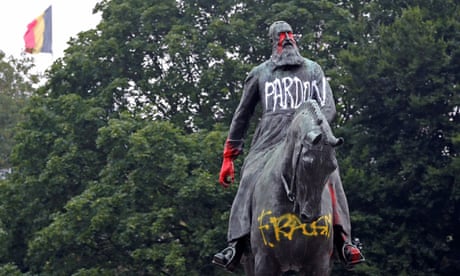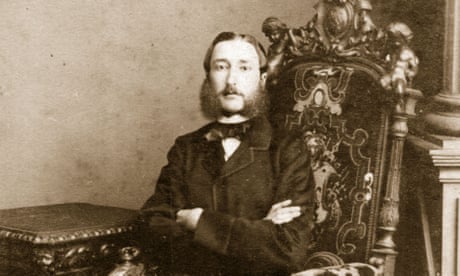
Triumphal arch in Cinquantenaire park ‘linked to exploitation of Congo’, says cultural group in Belgian capital
Jennifer Rankin in Brussels
THE GUARDIAN
Thu 18 May 2023
For many Belgians, the Cinquantenaire park in Brussels evokes memories of childhood visits to see the stuffed horses of the military history museum, or vintage cars at Autoworld, two institutions on the edge of the park.
The much-loved green space’s cheerful flowers and whimsical follies contrast with the steel canyons and beeping traffic of the adjacent EU quarter, but above all it is an expression of national pride, with a giant Belgian tricolour often suspended underneath a massive triumphal arch. Built in 1880 to mark 50 years of the Belgian state, Belgium’s federal government last month launched a redevelopment plan for the 200th anniversary in 2030.
Yet often overlooked are the traces of Belgium’s former colonial empire, embodied in monuments including the arch. At a recent public meeting to announce the 2030 “masterplan”, none of the dignitaries, including five Belgian government ministers, one EU commissioner and the minister-president of the Brussels capital region, mentioned its heritage.
In the slick prospectus for what was billed as “Europe’s most ambitious heritage project” – renovating the park’s museums and launching an architectural competition to cover the road that slices it in two – there was only one fleeting reference to decolonisation.

Call for Brussels statue to be melted and made into memorial for Congo victims
The silence is surprising because Brussels authorities last year published a detailed report on the decolonisation of public space in the Belgian capital, which included a section on the Cinquantenaire. Georgine Dibua Mbombo, a member of the 14-strong group of historians, architects and other specialists that produced the report, said it was “a little confusing” that there was no mention of the colonial past at that event, or in other city heritage plans. “It’s bizarre that in all the declarations we don’t see the will to say certain things,” she told the Guardian.
“For me the Parc du Cinquantenaire remains a park strongly linked to the exploitation of Congo,” said Dibua Mbombo, who runs Bakushinta, a group dedicated to promoting Congolese culture in Belgium.
The triumphal arch and semicircular arcades were built on the orders of Belgian King Leopold II, who ran the Congo as his personal fiefdom from 1885 to 1908. These grandiose structures were funded with the proceeds of Congolese rubber, a fact well known at the time – one Belgian socialist politician spoke of “the arch of severed hands”, a reference to the horrifying fate that awaited Congolese workers who failed to meet their rubber quota.
The park also houses prominent monuments to colonialism, including one to Gen Albert Thys, who oversaw the construction of a railway line that was indispensable for transporting Congo’s ivory and rubber wealth from the interior to the coast.

For many Belgians, the Cinquantenaire park in Brussels evokes memories of childhood visits to see the stuffed horses of the military history museum, or vintage cars at Autoworld, two institutions on the edge of the park.
The much-loved green space’s cheerful flowers and whimsical follies contrast with the steel canyons and beeping traffic of the adjacent EU quarter, but above all it is an expression of national pride, with a giant Belgian tricolour often suspended underneath a massive triumphal arch. Built in 1880 to mark 50 years of the Belgian state, Belgium’s federal government last month launched a redevelopment plan for the 200th anniversary in 2030.
Yet often overlooked are the traces of Belgium’s former colonial empire, embodied in monuments including the arch. At a recent public meeting to announce the 2030 “masterplan”, none of the dignitaries, including five Belgian government ministers, one EU commissioner and the minister-president of the Brussels capital region, mentioned its heritage.
In the slick prospectus for what was billed as “Europe’s most ambitious heritage project” – renovating the park’s museums and launching an architectural competition to cover the road that slices it in two – there was only one fleeting reference to decolonisation.

Call for Brussels statue to be melted and made into memorial for Congo victims
The silence is surprising because Brussels authorities last year published a detailed report on the decolonisation of public space in the Belgian capital, which included a section on the Cinquantenaire. Georgine Dibua Mbombo, a member of the 14-strong group of historians, architects and other specialists that produced the report, said it was “a little confusing” that there was no mention of the colonial past at that event, or in other city heritage plans. “It’s bizarre that in all the declarations we don’t see the will to say certain things,” she told the Guardian.
“For me the Parc du Cinquantenaire remains a park strongly linked to the exploitation of Congo,” said Dibua Mbombo, who runs Bakushinta, a group dedicated to promoting Congolese culture in Belgium.
The triumphal arch and semicircular arcades were built on the orders of Belgian King Leopold II, who ran the Congo as his personal fiefdom from 1885 to 1908. These grandiose structures were funded with the proceeds of Congolese rubber, a fact well known at the time – one Belgian socialist politician spoke of “the arch of severed hands”, a reference to the horrifying fate that awaited Congolese workers who failed to meet their rubber quota.
The park also houses prominent monuments to colonialism, including one to Gen Albert Thys, who oversaw the construction of a railway line that was indispensable for transporting Congo’s ivory and rubber wealth from the interior to the coast.

Black Lives Matter protesters with a DR Congo flag on a statue of Leopold II in Brussels.
Photograph: Yves Herman/Reuters
The monument to the “Belgian pioneers of the Congo”, completed in 1921, is perhaps the most notorious tribute to empire. “It is really one of the most horrible monuments in the Belgian public space. It cannot remain as it is because it is a monument that completely discredits the Congolese people,” Dibua Mbombo said.
Although weathered, the monument still displays all the hallmarks of colonial-era propaganda: a depiction of a nearly nude African woman offering her baby to a seated European; a “heroic” Belgian soldier crushing an “Arab” slave merchant under his foot. “I have undertaken the Congo project for the benefit of civilisation and the wellbeing of Belgium,” reads the inscription quoting a 1906 speech by Leopold II.
The monument to the “Belgian pioneers of the Congo”, completed in 1921, is perhaps the most notorious tribute to empire. “It is really one of the most horrible monuments in the Belgian public space. It cannot remain as it is because it is a monument that completely discredits the Congolese people,” Dibua Mbombo said.
Although weathered, the monument still displays all the hallmarks of colonial-era propaganda: a depiction of a nearly nude African woman offering her baby to a seated European; a “heroic” Belgian soldier crushing an “Arab” slave merchant under his foot. “I have undertaken the Congo project for the benefit of civilisation and the wellbeing of Belgium,” reads the inscription quoting a 1906 speech by Leopold II.

Belgium begins to face brutal colonial legacy of Leopold II
The former Belgian king is remembered on the other side of the park with an equestrian statue in the Royal Museums of Art and History. Next to the work is a plaque recounting the “unbridled capitalist greed … crime and dehumanisation” Leopold II showed in ruling the Congo. The museum’s director, Bruno Verbergt, said it is considering commissioning works by modern artists to sit nearby, with the aim of highlighting the reality of Belgian colonial rule.
The decolonisation group has also called on Brussels to make the history that has been ignored or forgotten visible. In the Cinquantenaire that could mean exhibitions about Congolese soldiers who fought for Belgium in the world wars in the military history museum, or research into the 1921 Pan-African Congress that took place in the building that now houses Autoworld. That gathering brought together luminaries such as WEB Du Bois, the African American intellectual and civil rights activist, and Paul Panda Farnana, a first world war veteran, whose fight for Congolese rights paved the way for independence. For now, Dibua Mbombo said, “there are many absences and things not spoken of”.
A spokesperson for the Brussels capital region said an action plan on the decolonisation of public space would be published by the end of May. The final recommendations will have to be signed off by the regional government.
Asked about the Cinquantenaire’s colonial heritage, the Belgian state secretary for strategic investments, Thomas Dermine, referred to the decolonisation report and said there would have to be discussions with the “communities involved”. He added: “If we remove all traces of the [colonial] past [it] is not a good solution, because if we remove these traces of the past, we lose also the opportunity to contextualise, to explain to a young generation behaviours that are out of step with our current values.”
But agreeing on how to “contextualise” a work glorifying the colonial past is not a simple question. Putting up a few information panels or QR codes is “not a solution”, Dibua Mbombo said, unconvinced that people read them. When it comes to the pioneers’ monument, she suggested a more radical option: breaking the work into pieces – a dramatic “decomposition” that would incentivise parkgoers to read panels on the work’s origins and fate.
No comments:
Post a Comment